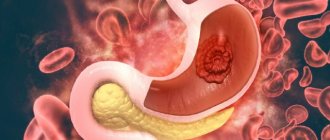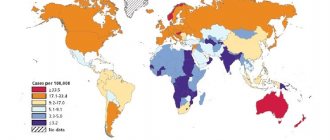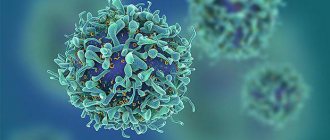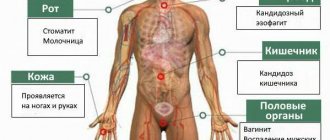Gastric cancer is a malignant tumor that develops from the epithelium of the mucous membrane of the organ. In the vast majority of cases, it is represented by adenocarcinoma, which accounts for up to 95% of all malignant tumors of this localization. Other cases include squamous cell carcinoma, carcinoid, and there may also be non-epithelial tumors - lymphomas or sarcomas.
- Reasons for development
- Diagnostics
- Treatment
- Lifespan
- Prevention
In stage 3 gastric cancer, three substages are distinguished, depending on the extent of the tumor.
At stage 3A:
- The tumor has grown into the outer serous lining of the stomach. There is damage to 1-2 lymph nodes.
- Gastric cancer does not extend beyond the subserous layer, but there is evidence of damage to 3-6 regional lymph nodes.
- The tumor is less invasive, spreading only to the muscular layer of the gastric wall, but 7 or more regional lymph nodes are affected.
At stage 3B:
- The cancer grows in the subserous layer of the gastric wall, and 7 or more lymph nodes are affected.
- The cancer has spread to the serosa of the stomach, and 3-6 lymph nodes are affected.
- The tumor extends beyond the stomach, affecting neighboring organs - the liver, intestines, diaphragm, pancreas, no more than 2 lymph nodes are affected.
Stage 3C:
- The tumor has grown into neighboring organs and 3 lymph nodes are affected.
- The cancer has spread to the serous layer and metastasized to 7 or more regional lymph nodes.
Book a consultation 24 hours a day
+7+7+78
Causes of stomach cancer
Gastric cancer is a multifactorial disease. Risk factors can be divided into irreducible and avoidable.
Unavoidable risk factors include:
- gender (men get sick more often);
- age (as you get older, your risk of developing cancer increases);
- genetic predisposition (cases of the disease in relatives).
Removable causes include:
- Helicobacter pulori infection (it has been proven that these microorganisms are involved not only in the occurrence of gastritis and peptic ulcers, but also have a direct mutagenic effect, causing intestinal metaplasia and dysplasia of the gastric epithelium, atrophy of the mucous membrane);
- nature of nutrition: foods with a large amount of nitrates, nitrites (processed meat, for example, sausages, some hard cheeses), smoked foods (contain toxic polycyclic carbohydrates), foods rich in starch;
- smoking and alcohol abuse;
- the presence of precancerous diseases: gastric polyps, chronic gastric ulcer, chronic gastritis, hypertrophic gastritis (Menetrier's disease), pernicious anemia.
Particular importance in the occurrence of stomach cancer is given to N-nitroso compounds (formed by the interaction of nitrites with amines and amides), which are found both in food products (salted and smoked meat and fish products) and are formed naturally in the environment and the human body.
The increase in the incidence of stomach cancer is also associated with the characteristics of the soil and water. It has been established that in areas with acidic soil rich in organic compounds, rates of gastric malignancy increase.
Predisposing factors for carcinogenesis are work in the production of rubber, mineral oils, contact with asbestos, chromium, and vinyl chloride.
The effect of ionizing radiation on the development of stomach cancer has not been fully studied, but high background radiation is considered a risk factor.
Possible consequences of chemotherapy
Chemotherapy works by stopping or slowing the growth of cells that are growing and dividing rapidly. Cancer cells form new cells faster than healthy cells, making them a better target for chemotherapy. However, cells in the bone marrow, the lining of the oral cavity and intestines, and hair follicles also divide rapidly. Classic chemotherapy drugs cannot distinguish healthy cells from cancer cells. This causes normal cells to be damaged along with cancer cells, which causes side effects.
Depending on the type of medication, its dose, and the length of treatment, various side effects may occur. Most chemotherapy drugs have the following side effects:
- Nausea and vomiting;
- Loss of appetite;
- Hair loss;
- Diarrhea;
- Mouth ulcer;
- Weakened immunity and increased risk of infection (due to a deficiency of leukocytes);
- Bleeding or slight bruising (due to low platelet levels in the blood);
- Fatigue and shortness of breath (from low red blood cell levels and other causes).
These side effects are short-term and go away after chemotherapy ends. Before starting treatment, your doctor will tell you about any side effects you may experience.
Some chemotherapy drugs have specific side effects, for example:
- Oxaliplatin can also affect the nerve endings in the throat, causing a sore throat. It may get worse when trying to eat or drink cold foods, which can lead to difficulty swallowing or even breathing, and may last for several days after treatment.
- Doxorubicin, epirubicin, and some other drugs can cause permanent heart damage when used long-term or in high doses. Therefore, doctors carefully monitor the doses of such medications and heart function. At the first sign of heart damage, treatment is stopped.
- Hand-foot syndrome may occur when being treated with drugs such as capecitabine or 5-FU. It manifests as redness on the hands and feet, which can then lead to pain and tenderness in the palms and soles. If the condition is neglected, blistering or peeling of the skin can occur, sometimes leading to open and painful skin lesions.
Monitor your condition and report any changes to your doctor so that he can make timely adjustments to your treatment plan or stop it. There are also methods that help prevent or reduce unwanted symptoms. For example, your doctor may prescribe medications to help prevent or reduce vomiting or nausea.
Symptoms of stomach cancer
There are no specific clinical manifestations of gastric carcinoma; moreover, the tumor can be asymptomatic for a long time. The first signs of stomach cancer may be the so-called “minor symptoms”:
- general weakness and lethargy, fatigue and decreased ability to work;
- decreased appetite, feeling of early satiety, aversion to meat and fatty foods;
- sudden unexplained weight loss;
- increasing anemia (decrease in the number of red blood cells and hemoglobin level in the blood);
- sleep disorders;
- increased body temperature;
- discomfort and pain (pressing, bursting, aching) in the stomach;
- dyspepsia (belching, nausea, vomiting).
As the tumor grows, so do the symptoms.
- The pain becomes unbearable and becomes permanent. When cancer grows into the pancreas or metastases (tumor screenings) appear in the lymph nodes of the retroperitoneal space, pain can radiate to the lower back.
- The belching becomes foul. Vomiting becomes more frequent, and blood may be found in the vomit. With persistent vomiting, water and electrolyte disturbances develop, up to tetany (convulsive syndrome).
- When carcinoma grows into the esophagus, swallowing is impaired and excessive salivation occurs.
- If the tumor metastasizes to the liver, jaundice and itchy skin will be noted.
- The spread of the tumor throughout the peritoneum is manifested by ascites (accumulation of fluid in the abdominal cavity.).
Stomach cancer can be complicated by bleeding from the tumor, which will be accompanied by weakness, palpitations, dizziness, vomiting blood and tarry stools.
Perforation will be characterized by “dagger” pain, cold sweat, severe weakness up to loss of consciousness.
Stomach cancer often occurs against the background of chronic stomach diseases (chronic gastritis, peptic ulcer) and can hide for a long time under the mask of their symptoms, which makes it difficult to make a diagnosis in the early stages. Therefore, patients with chronic gastric diseases are recommended to undergo fibrogastroduodenoscopy (FGDS) at least once every two years.
How is chemotherapy administered and what is the duration of the course?
Chemotherapy drugs are most often given as tablets and intravenous injections lasting a few minutes or as infusions over a longer period of time.
Chemotherapy is given in cycles, alternating between treatment and recovery periods to give the body time to recover from the effects of the drugs. The duration of cycles is most often several weeks, and the initial number of cycles is usually from 4 to 6. The schedule varies depending on the drugs used. For example, for some medications, chemotherapy is prescribed only on the first day of the cycle. For others - for several days in a row or once a week. Then, at the end of the cycle, repeats to begin the next cycle.
Diagnosis of stomach cancer
- Anamnesis collection. Complaints and the presence of chronic stomach diseases in the patient and his immediate family are clarified.
- Physical examination. Attention is focused on the color of the skin (pallor with anemia, jaundice with metastases to the liver), dry skin, slow straightening of skin folds, and a decrease in the thickness of subcutaneous fat. The abdomen and superficial lymph nodes are palpated.
- A digital rectal examination is performed in men to determine metastases in the pararectal lymph nodes, and a rectovaginal examination in women is performed to determine metastases in the pararectal lymph nodes and ovaries.
- FGDS with biopsy. Makes it possible to visually determine the presence of a tumor, assess its size, growth pattern, presence of ulcerations, and take a piece of the tumor for subsequent morphological examination.
- Endoscopic ultrasound examination. Helps examine the walls of the stomach and esophagus. This method shows the boundaries of the tumor with very high accuracy.
- Morphological examination (histological and immunohistochemical examination) is an examination of tumor tissue under a microscope, which makes it possible to determine the type of tumor and prescribe appropriate treatment.
- X-ray examination of the stomach using a contrast agent. Allows you to determine the shape, size of the tumor, its prevalence. Particularly effective for infiltrative forms of cancer.
- Ultrasound of the cervical-supraclavicular region, abdominal organs, retroperitoneal space and pelvis. Allows you to determine the extent of the tumor and the presence of metastases.
- X-ray of the chest organs. Allows you to determine the presence of metastases in the lungs.
- CT scan.
- PET/CT.
- Laparoscopy is an examination of the abdominal cavity through a puncture of the anterior abdominal wall using a special device. It is carried out to clarify the spread of cancer to neighboring organs and structures, along the peritoneum, and to detect ascites.
- Osteoscintigraphy. Performed if bone metastases are suspected
- Colonoscopy.
- Complete blood count (determining the number of red blood cells, leukocytes, hemoglobin level, ESR).
- Biochemical blood test (total protein, albumin, bilirubin, urea, creatinine, electrolytes, amylase).
- Tumor tumor markers – CEA, CA 72-4, CA 19.9. Currently, this combination of markers is recommended for diagnosing gastric cancer, monitoring the course of the disease and the effectiveness of therapy.
Specific symptoms
When the oncological process is neglected, a defect appears such as black stool in a liquid state; vomiting also occurs. Such deviations indicate the presence of internal bleeding. With such symptoms, it is urgent to take prompt measures to stop the bleeding. The list of complications also includes intestinal obstruction of the initial section (sometimes the patient cannot even drink water). These signs are present during the growth of cancerous foci of the cardiac region and subsequent closure of the esophageal lumen.
Stages of stomach cancer
There are five stages of gastric carcinoma, which are determined based on the depth of tumor growth into the stomach wall, its spread to neighboring organs, and metastasis to regional and distant lymph nodes.
Stage 0. Precancerous stage, diagnosed with a small tumor located within the gastric mucosa.
Stage 1. Cancer spreads to the submucosal layer and metastasizes to single (up to 6) regional lymph nodes. The 5-year survival rate reaches 95%.
Stage 2. The cancer has grown into the outer layer of the stomach wall, possibly affecting up to 15 lymph nodes. The chance of surviving more than five years after treatment is close to 50%.
Stage 3. The tumor grows into the serosa of the stomach, spreads to neighboring organs (transverse colon, small intestine, liver, spleen, kidneys), multiple lesions of the lymph nodes. The effectiveness of treatment, estimated by 5-year survival rate, is 15-40%.
Stage 4. The tumor covers not only organs located near the stomach, but also distant ones, including the lymph nodes. Only 5% of patients with stomach cancer at this stage have a chance to live more than five years.
Prevention
Prevention of stomach cancer comes down to minimizing risk factors that increase the likelihood of developing this disease:
- Normalization of nutrition.
- Timely treatment of stomach diseases: ulcers, gastritis, removal of polyps.
- To give up smoking.
- Timely completion of gastroscopy by patients at risk.
- Compliance with the physical activity regime.
| More information about the treatment of stomach cancer at the Euroonco clinic: | |
| Treatment of stomach cancer | |
| Oncologist-gastroenterologist | RUB 5,100 |
| Chemotherapy appointment | RUB 6,900 |
| Emergency oncology care | from 12,100 rub. |
| Radiologist consultation | RUB 11,500 |
Book a consultation 24 hours a day
+7+7+78
Treatment of stomach cancer
Treatment tactics for stomach cancer depend on the stage of the process.
Surgical treatment is the main method. The extent of surgery depends on the extent of the carcinoma.
For small tumors localized in the gastric mucosa, endoscopic removal is possible. With this method of treatment, the affected area of the gastric mucosa is removed, sometimes along with the submucosal layer.
At later stages of cancer, a subtotal resection of the stomach is performed (removal of part of it, maybe proximal - removal of the section closest to the esophagus or distal, removal of the outlet section.
If a tumor of the body of the stomach (its middle part) occurs, then a gastrectomy is performed - complete removal of the stomach with regional lymph nodes.
If the tumor grows into neighboring structures (spleen, intestines, pancreas, etc.) without signs of distant metastases, their removal or en bloc resection is indicated.
At stage 4 of gastric cancer, palliative surgical treatment is possible, aimed at improving the patient’s condition and correcting symptoms. This type of operation includes: palliative gastrectomy; the formation of a gastroenteroanastomosis, which is a bypass anastomosis between the intestinal loops and the stomach - thus creating a new path through which food will pass; removal of gastro- or jejunostomy, which are artificial entrances to the stomach or intestines through the abdominal wall for feeding the patient; performing endoscopic recanalization to restore the passage of food through the stomach (endoluminal laser therapy, stenting).
Chemotherapy treatment for stomach cancer may be given after surgery to kill any cancer cells that may remain after surgery, or before surgery to reduce the size of the tumor.
Chemotherapy is used for stomach cancer of stage 2 and subsequent, and sometimes at the initial stage of the disease. Modern methods have allowed chemotherapy to become more effective, but cancer still cannot be defeated without additional treatments. For inoperable stage 4 cancer, treatment with chemotherapy can stop the process of metastasis and prolong the patient’s life.
Radiotherapy is also a commonly used procedure and is used exclusively in conjunction with surgery and chemotherapy. With its help, damage to healthy tissue is minimized, a targeted effect is exerted on the affected organs, and the intensity of pain during metastases is reduced. This treatment is usually used after surgery to “kill” remaining cancer cells or shrink metastases.
Targeted or molecularly targeted (“molecular targeted”) therapy. In this procedure, active molecules specially created to fight cancer cells are injected intravenously. These drugs are good because they work precisely, since their effectiveness is associated with certain molecular genetic properties of cancer cells, and do not affect healthy tissue. Targeted therapy can be used either alone or in conjunction with other treatments, and can be used for any degree of cancer. The drugs are administered intravenously.
After treatment, patients are constantly under medical supervision. Observation mode: first year, once every 3 months; second year once every 6 months; in the future – once a year.
What to do if the tumor cannot be removed surgically?
If you are healthy enough to have major surgery, but the tumor is so widespread that surgery will not be successful, you have other treatment options.
- Chemoradiation therapy as an attempt to cure cancer. It is also called radical chemoradiotherapy.
Chemotherapy regimens recommended for radical chemoradiotherapy
| Preferred Modes | Fluorouracil and oxaliplatin |
| Fluorouracil and cisplatin | |
| Fluoropyrimidines (fluorouracil or capecitabine) and paclitaxel |
- Systemic chemotherapy (see “Metastatic gastric cancer”).
Nutrition of the patient
The diet for stage 4 stomach cancer should be balanced and include all the necessary vitamins and microelements. Properly organized nutrition stimulates metabolism, normalizes blood composition, the functioning of the gastrointestinal tract, and increases the immunity of a cancer patient.
The basis of the patient's menu consists of:
- vegetables (fresh or cooked);
- meat, low-fat fish;
- fruits;
- dairy products;
- berries.
You will have to exclude from the diet:
- alcoholic drinks;
- pickles;
- fatty, fried foods;
- marinades;
- sweets;
- legumes;
- canned food;
- semi-finished products;
- flour;
- smoked meats;
- fast food.
The patient needs to eat in small portions - 5-6 times a day. Boil or steam the food, then grind in a blender until semi-liquid. All foods must be warm (not hot or cold).
A cancer patient needs to drink more fluids. Preference should be given to berry fruit drinks, natural juices diluted with water in a 1:1 ratio. Consumption of strong tea and coffee should be minimized. Carbonated drinks, packaged juices - completely avoid.
When a patient with stage 4 cancer cannot feed on his own, he is fed through a gastrostomy tube with special formulas. You can buy them or make them yourself from products recommended by your doctor.
Forecast
Questions arise: can cancer be cured? How long do you live with stomach cancer? The lifespan of a patient with stage 4 stomach cancer depends on a combination of several factors:
- person's age;
- general condition of the body;
- lifestyle before illness;
- type of tumor;
- quantity, nature of metastases.
In general, the prognosis for such a tumor is extremely unfavorable. The five-year survival threshold is exceeded by 4% of patients with stage 4 gastric cancer. However, one must not despair. According to medical research, the patient’s psychological mood has a huge impact on the outcome of treatment.
Stage 4 stomach cancer is a dangerous incurable disease. But modern treatment methods help prolong the patient’s life and maintain it at a decent level for a long time. It is important for the patient’s relatives to support him and ensure that all recommendations are carefully followed.
has been organizing high-quality individual medical care for many years.
Over the years of work, we have accumulated statistics on leading foreign clinics and are ready to recommend to patients for pregnancy management after breast cancer only those medical centers where they will truly provide the most effective care.
Prevalence of the disease
Stomach cancer is a fairly common disease that develops and metastasizes quickly.
Around the world, about 8 million people die from stomach cancer every year, and in Russia - about 48,000. The spread of this disease in different countries is uneven. Japan, Russia, Brazil, and Finland are considered regions with high incidence and mortality rates from stomach cancer. Residents of Central Asia, the Transcaucasian republics, the USA, Mexico and some other countries get sick less often. This is mainly associated with the nature of nutrition, lifestyle, and environmental factors. People over 50 years of age are predominantly affected. However, recently, malignant tumors are increasingly occurring at a younger age. According to some data, stomach cancer occurs more often in men (32%) than in women (21%). However, not all researchers agree with this. It is important to note that early forms of stomach cancer are treated very successfully, but because symptoms of the disease appear late, people often present for testing and treatment too late.









